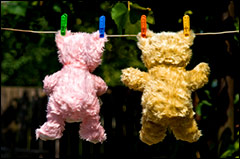Dear Umbra,
What are the “green” high-efficiency detergents for washers?
Thanks,
Marilyn
Dearest Marilyn,
A perfect question for parenting fortnight. Children have such tiny clothing that you wouldn’t think it would add up to an increase in laundry volume. Until you saw the proof. Too bad keeping them naked (cuuuute!) and periodically hosing them off is only feasible in warm weather.

Pin your hopes on NPE-free.
Photo: iStockphoto
A greener detergent will omit certain cleaning and odorizing agents, whether it is high-efficiency or regular old detergent. High-efficiency washing machines use less water, so regular old detergents (ROD) don’t clean as well, and may leave residue, in the HE machines. It looks to me (in the supermarket and online) as if most major detergent labels now offer HE detergent.
The No. 1 ingredient to avoid is the surfactant nonylphenol ethoxylate. NPE breaks down into NP (nonylphenol, please don’t make me spell it any more), an endocrine disruptor (and estrogen mimic) that has been seen to affect male fishes. Since detergent goes out in household wastewater, and NPEs are quite difficult to remove during sewage treatment, we should avoid putting NPE into the water in the first place.
Unfortunately for us shoppers, it’s not on the ingredient label unless the company specifically mentions not having it. One stealthy divination technique for shoppers is to avoid nonionic surfactants — because NPE is one. And what is a surfactant, you may ask? My science mash-o-matic seems to be busted and I feel a little confused about surfactants. They lower the surface tension of water, and this is related to their ability to keep dirt lifted away from clothes during a washing process, instead of the dirt resettling upon the clothing. I believe they are usually petroleum based.
The Sierra Club and other groups are petitioning the EPA to do further research, mandate labeling of NPE in products, and ban its use in industrial products. You may wish to join the petition, or read more about it.
Phosphates are another downstream pollutant that may be present in a laundry detergent. Phosphates will act as a fertilizer in waterways and cause accelerated algal growth, messing up the ecosystem. The phosphate-free label is much easier to find than the NPE-free label. Bleach is also something to look out for in a laundry detergent, as it is a lung irritant. Fragrances can be irritating, so we might as well avoid those. Let’s see … biodegradability is a big buzzword with cleaners of all sorts, but I’ve read varying reports about its relevance. NPE is apparently the main poorly biodegradable surfactant to watch out for. Other than that, biodegradable claims should be specific (e.g., biodegrades in 30 days) or we shouldn’t pay for them.
The petroleum content of cleaners does raise other issues, of course. Walking to the store and buying a P&G detergent is probably better than driving to buy a lower-petroleum detergent.
All this takes us to the meat of your question. You want the name of a greener HE detergent. Well, any Procter and Gamble detergent will be NPE-free, since the company stopped using the chemicals a few years back. A few Wal-Mart and Costco detergents are NPE-free, and many smaller companies claim NPE-freeness, so a web hunt will turn up some other labels. In the store, read labels carefully — and don’t believe unsubstantiated, vague claims (e.g., “natural”).
Tidely,
Umbra


